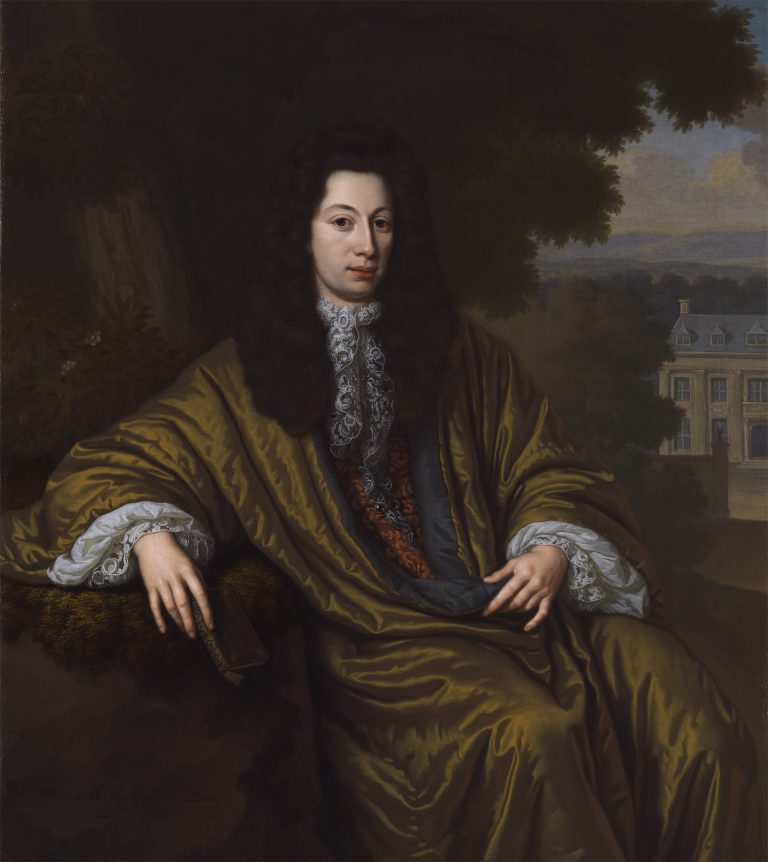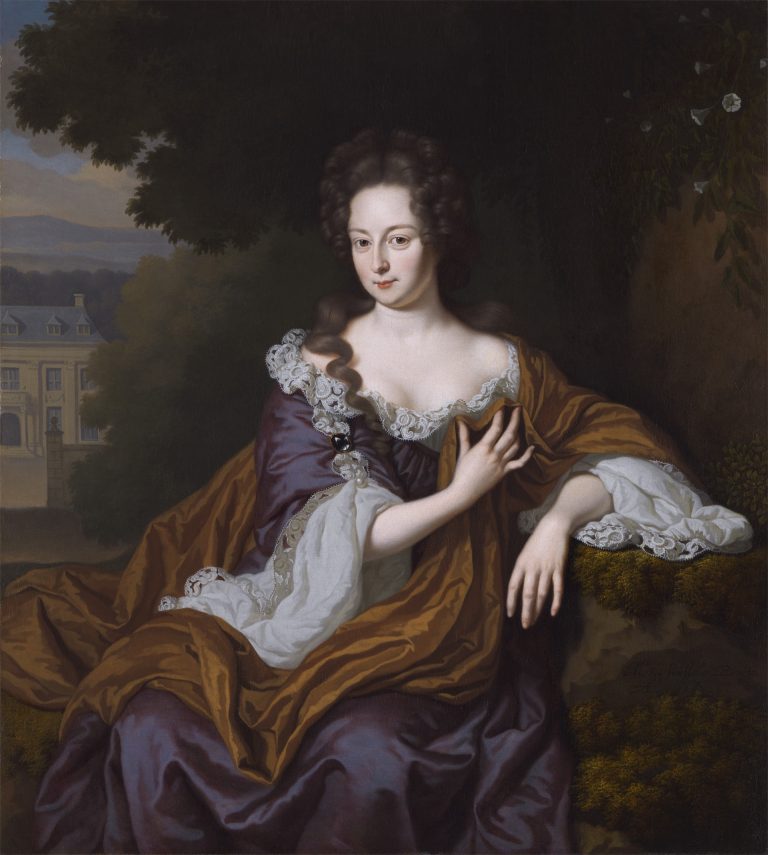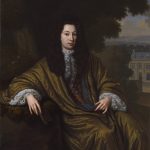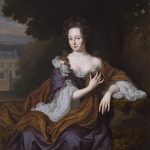Michiel van Musscher painted with great finesse these elegant three-quarter-length pendant portraits of a young upper-class couple in a garden. Seated on the heraldic right, the man is dressed in a fashionable, exotic, golden-brown silk Japonse rok, which falls open at his torso, revealing a red brocaded undergarment.1 His jabot and cuffs are adorned with fine floral lace, and on his head he wears a dark brown, curly wig. With his right arm he leans on a mossy wall, while the slender fingers of his right hand hold a small book with a black leather and gold binding. His pose, directed slightly to the right, is mirrored by that of his wife, who has turned slightly toward the left. She is wearing an elegant, purple silk gown trimmed with lace identical to that of her husband. Around her left shoulder and draped over her lap is an orange-brown silk scarf, similar in tone to her husband’s garment. When seen together, the two paintings provide a continuous view of a country estate in a lush setting before a distant, mountainous landscape.
With his characteristic attention to detail, Van Musscher took great care in rendering the textures of the various fabrics. He attained the shimmering effect of silk in the man’s Japonse rok and the woman’s dress by boldly applying the highlights with broad brushstrokes, often playfully following the direction of the folds. The much more delicate lace, on the other hand, was painted with thin, barely visible strokes. Using a grayish tone as the base for the lace and adding pure white for the highlights, Van Musscher exquisitely depicted the subtle contrasts between light and shadow, a quality seen in the shadow cast by the proper right sleeve of the man’s blouse onto its lace edging (fig 1). He created a similar effect in the contrast between the shaded reverse of the lace around the woman’s proper right sleeve and the highlighted front of the lace at her neckline (fig 2).
Old handwritten inscriptions on the reverses of the canvases identify the sitters as 26-year-old Pieter Ranst Valckenier (1661–1704) and his 17-year-old wife, Eva Suzanna Pellicorne (1670–1732) ((fig 3) and (fig 4)). Valckenier and Pellicorne were married in 1686, which suggests that they commissioned these paintings, dated 1687, as marriage portraits. Pieter’s father was the influential Gillis Valckenier (1623–80), who had been the director of the Dutch East India Company (VOC) and remained active in the municipal government of Amsterdam until his death.4 Pieter, too, held several important positions in the Amsterdam municipal government until he eventually became director of the VOC in 1693.5 The fact that Pieter is wearing a Japanese gown reflects his family’s high position in this trading company as much as his upper-class fashion status. Eva Suzanna Pellicorne was the daughter of the wealthy Casper Pellicorne and Clara Valckenier, Gillis Valckenier’s sister, making Pieter and Eva Suzanna first cousins as well as spouses.6
It is likely that the outdoor mansion in the idealized, hilly landscape in the background of the pendant portraits is Gynwens in Baambrugge, just south of Amsterdam. Pieter inherited this manor from his father in 1680, and Eva Suzanna continued to live there after her husband’s death in 1704. A few years before her death in 1727, she sold this property to Joan van der Voort (1667–1727), the husband of her cousin Anna Jacoba Valckenier (1676–1743).7 Unfortunately, this mansion no longer survives, and an etching of a country house named Gynwens that appears in Abraham Rademaker’s Holland’s Arcadia, 1730, depicts a different property (fig 5).8 The Valckenier family, however, owned other mansions in the same vicinity near Amsterdam, and one of them, Valck en Heining, in Loenersloot, still exists (fig 6). The similarity in the appearance of this country house and the structure in the background of the pendant paintings supports the hypothesis that Van Musscher depicted Gynwens in these works. It seems probable that Pieter’s second cousin Cornelis (1640–1700), who built Valck en Heining in 1677,9 based his design on Gynwens.
When Van Musscher painted these portraits in 1687, he was one of the most popular and frequently commissioned portraitists of the Amsterdam elite. Among his many distinguished clients were members of the Van Loon, Blaeu, and Witsen families, and even Czar Peter the Great of Russia, who commissioned a portrait during his visit to the Netherlands in 1697–98.10 Van Musscher’s portraits of Pieter Ranst Valckenier and Eva Suzanna Pellicorne are comparable to other pendant portraits he painted of distinguished couples between 1680 and 1700, such as his 1681 portraits of François le Gillon and Christina Backer (fig 7), or his 1696 portraits of Nicolaes Kalkoen and Agatha van Loon.11
In all of these paintings, the elegant couples, just like Pieter and Eva Suzanna, are dressed in lush silks, reveal slender, elongated fingers, and stand in an idealized, pastoral landscape, often with a mansion or landscape extending across the pendants. This courtly style of portraiture was extremely popular among the Dutch upper class in the late seventeenth century and was indebted to the late portraits of the Flemish artist Anthony van Dyck (1599–1641) and the Dutch artists he inspired, such as Jan Mijtens (ca. 1614–70), Caspar Netscher (ca. 1639–84), and Nicolaes Maes (1634–93).12 Clearly this style, in which Van Musscher excelled, was highly sought after in the elite circles of Amsterdam.



